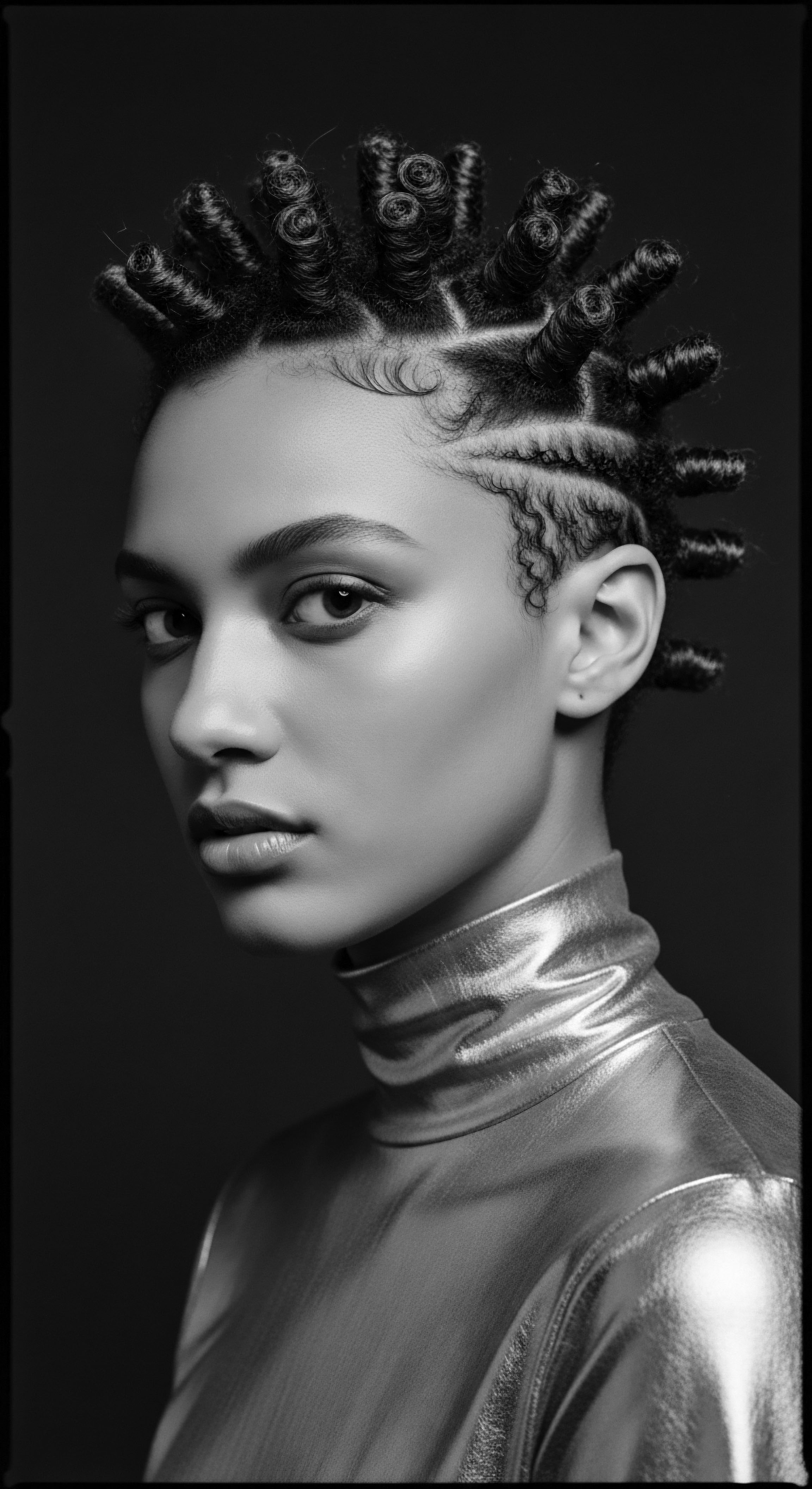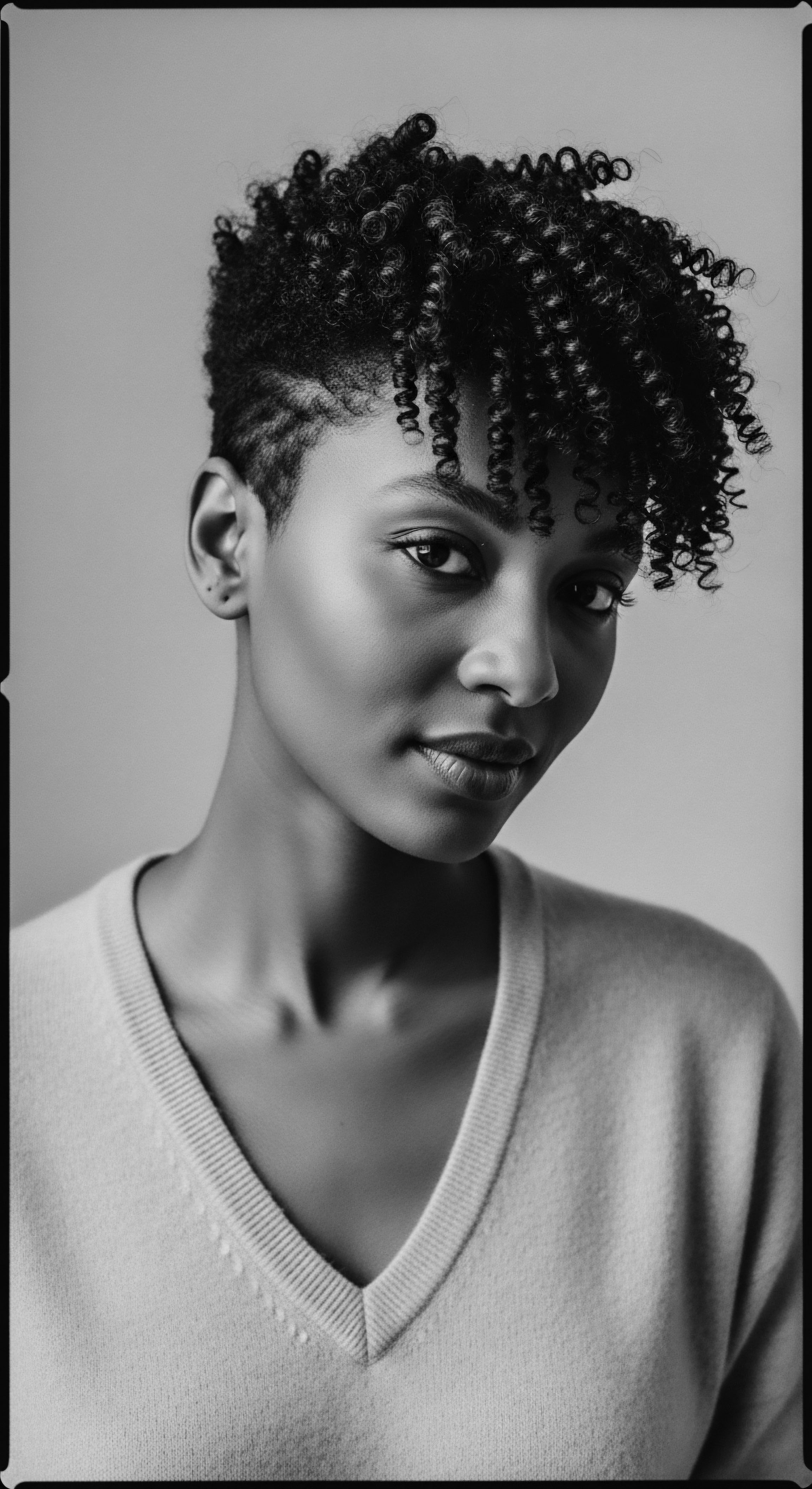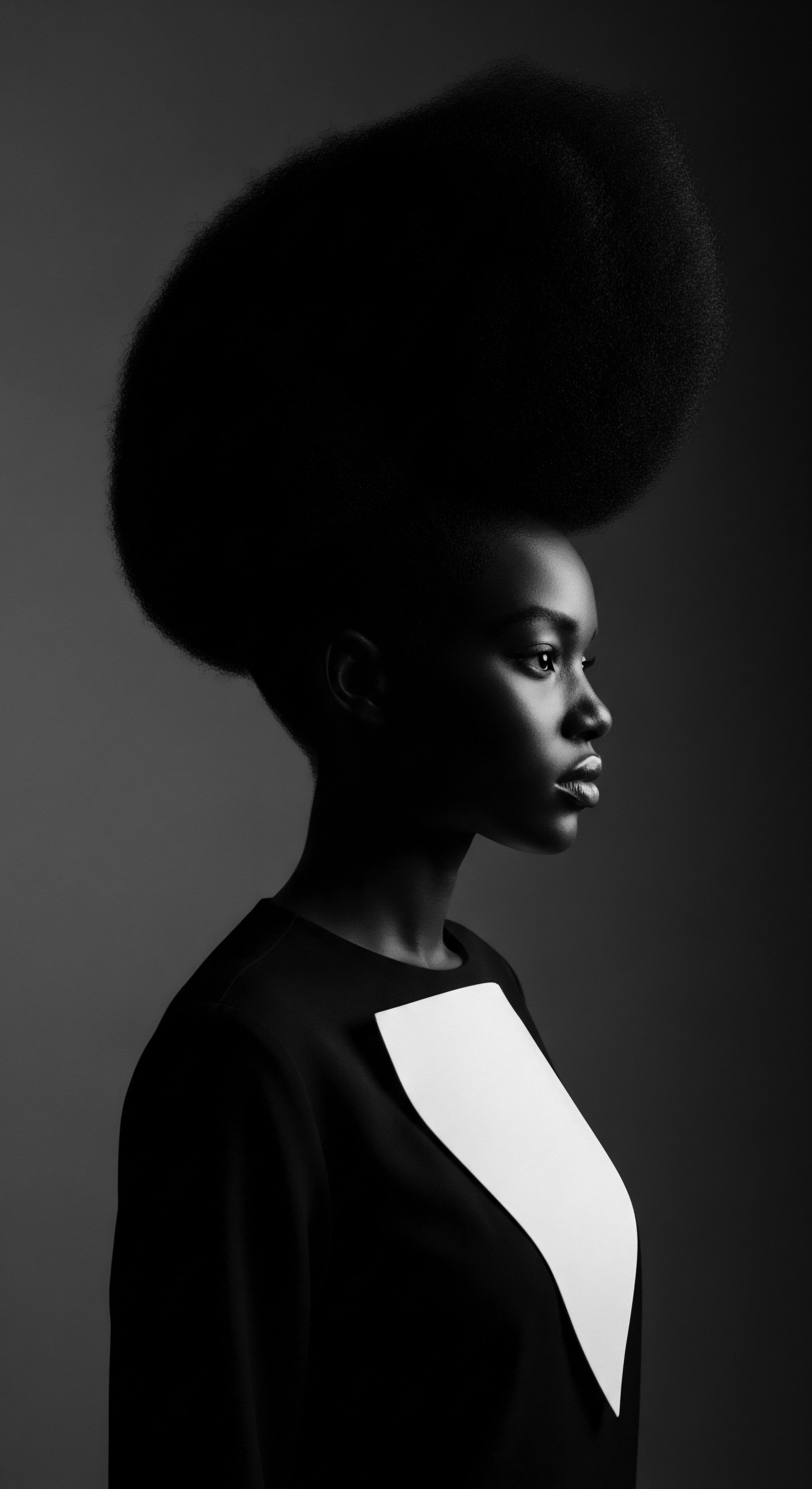
Roots
There exists a profound, unspoken language woven into the very coil of a strand of hair, particularly for those of Black heritage. It is a lexicon steeped in antiquity, resonating with the cadence of ancestral voices and the whisper of sun-drenched earth. To truly grasp how cultural meaning sculpted hair hydration rituals for Black heritage, one must first feel the texture, not just as a physical attribute, but as a living archive.
Consider, for a moment, the hair upon your head—a living fiber, yes, but also a silent narrator of journeys undertaken, wisdom passed down, and resilience manifested. This is not simply about conditioning a fiber; it reaches into the heart of identity, belonging, and a continuum of care that has been, and remains, a sacred practice.

Hair Anatomy and Physiological Echoes
The biological blueprint of textured hair, with its unique elliptical follicle shape and varied curl patterns, profoundly influenced early hydration strategies. The spiraling architecture of kinky, coily, and curly strands means that natural oils produced by the scalp, known as sebum, struggle to travel down the hair shaft as readily as they might on straight hair. This inherent structural quality makes textured hair naturally prone to dryness.
Early communities, perhaps without formal scientific frameworks, observed this truth. Their observations led them to formulate care practices that actively countered this dryness, often employing a deep reliance on the bounty of their natural environments.
The cuticle, the outermost layer of the hair, consisting of overlapping scales, tends to be more open or raised in textured hair. This characteristic, while allowing for impressive volume and spring, also permits moisture to escape more readily. Hydration rituals thus became paramount, not merely a cosmetic choice but a physiological necessity for maintaining the hair’s strength and pliability. One can observe this in the careful manipulation of hair, often using specific tools or finger-lacing, which distributed natural emollients and sealed in water.

Ancestral Knowledge of Hair’s Nature
Long before microscopes revealed the secrets of the hair shaft, generations possessed an intuitive understanding of what their strands required. This knowledge was passed down through observation, familial instruction, and communal gathering. The very act of caring for hair was often a shared experience, particularly among women, transforming a biological need into a deeply social and spiritual ritual.
These practices acknowledged hair as a living extension of self, deserving of reverence and consistent, intentional moisture. The concept of hydration, therefore, became intertwined with the very well-being of the individual and the collective.
Hair’s unique biological structure necessitated ancestral wisdom to develop specialized hydration practices, ensuring vitality and cultural preservation.

Understanding the Lexicon of Textured Hair Care
The language used to describe textured hair and its care rituals speaks volumes about their cultural significance. Terms like “coil,” “kink,” “curl,” and “wave” are more than mere descriptors; they denote the diverse expressions of hair within Black heritage. The practices associated with hydration also garnered specific terminology, often reflecting the ingredients or the methods employed. These words, passed down through generations, became integral to the cultural tapestry, signifying a collective understanding and appreciation for hair’s inherent beauty and needs.
For instance, the word “lubrication”, while scientific, finds its cultural counterpart in practices like oiling, where specific plant-derived substances were applied with intention. The concept of “moisture Retention” was understood through the observed benefit of sealing practices, long before the terms “occlusive” or “humectant” entered the scientific lexicon. These traditional terminologies, though perhaps not formalized in textbooks, carried profound meaning within their respective communities, guiding the effective hydration of hair.

Ritual
The journey of hair hydration within Black heritage extends far beyond simple application; it is a meticulously choreographed ritual, deeply embedded in social fabric and imbued with profound cultural meaning. From the earliest communal gatherings to modern individual practices, the act of moisturizing hair has never existed in a vacuum. It represents a living dialogue between the past and the present, a tangible link to ancestral wisdom, and a powerful assertion of identity. This engagement with moisture, in its many forms, became a cornerstone of care, transmitting knowledge and values from one generation to the next.

Communal Care and Generational Wisdom
In many ancestral African societies, hair care was a collective endeavor, especially among women. These moments were not merely about grooming; they were profound occasions for storytelling, mentorship, and the transmission of cultural norms. Younger generations observed and participated, learning the intricate dances of application—how to separate strands, how to warm oils, how to gently work moisture into the very core of the hair.
This communal aspect ensured that knowledge of effective hydration, whether from plant butters or water sources, remained a living heritage, adapting and evolving across time. The act of sharing these rituals reinforced familial bonds and community cohesion, making hydration a shared cultural inheritance.

What Traditional Hydration Ingredients Were Cherished?
The landscapes of Africa and the diaspora offered a rich pharmacy of natural ingredients. Communities learned, through trial and error over centuries, which plants, butters, and oils provided the most benefit for their hair. These ingredients were selected not only for their physical properties but also for their symbolic meanings. Many were believed to hold protective, healing, or spiritual qualities, further elevating their role in hair hydration rituals.
- Shea Butter ❉ Sourced from the nuts of the shea tree, native to West Africa, shea butter was (and remains) a powerhouse for moisture. Its rich fatty acid profile provides exceptional emollience, forming a protective barrier on the hair shaft that locks in hydration. Its cultural significance lies in its widespread use not just for hair, but for skin, food, and traditional medicine, making it a truly foundational ingredient across many communities.
- Coconut Oil ❉ Prevalent in coastal West Africa, the Caribbean, and other diasporic regions, coconut oil penetrates the hair shaft effectively, reducing protein loss and providing deep moisture. Its cultural role extends to its use in cooking, ceremonies, and holistic wellness.
- Baobab Oil ❉ Extracted from the seeds of the majestic baobab tree, this oil is rich in vitamins and essential fatty acids. Used in parts of Southern and East Africa, it contributed to hair’s softness and elasticity, supporting hydration by nurturing the hair’s structure.
- Aloe Vera ❉ Known for its humectant properties, aloe vera was widely used in various forms across many regions. Its clear gel was applied directly to hair and scalp to soothe, condition, and attract environmental moisture, making it a natural hydrator.

The Nighttime Sanctuary and Bonnet Wisdom
The practice of protecting hair at night is a critical aspect of hydration rituals, particularly within Black heritage. This habit, perhaps dismissed by some as a modern convenience, possesses deep historical roots. In many African societies, hair was not simply left unbound overnight.
Protective coverings, from intricately woven headwraps to simple fabric coverings, guarded elaborate styles and maintained moisture. The modern bonnet, a ubiquitous item in many Black households, is a direct descendant of these ancestral practices.
Sleeping with hair exposed to absorbent fabrics like cotton can strip strands of their precious moisture, leading to dryness, breakage, and tangles. The bonnet, typically made of silk or satin, creates a smooth, friction-free environment that preserves the hair’s hydration, reduces mechanical damage, and extends the life of protective styles. It’s a simple yet profound testament to a legacy of care that understood the necessity of protecting hair even during rest, ensuring continued hydration.
| Traditional Ingredient Shea Butter |
| Historical Significance Ubiquitous across West Africa for skin, hair, and medicine; seen as a sacred resource. |
| Modern Scientific Understanding for Hydration Rich in oleic and stearic acids, forming an occlusive barrier to prevent transepidermal water loss from hair. Provides deep conditioning. |
| Traditional Ingredient Black Soap (Alata Samina) |
| Historical Significance Originating from West Africa; used for cleansing and sometimes as a base for hair treatments. |
| Modern Scientific Understanding for Hydration Contains plantain peels, cocoa pods, and shea tree bark, which can provide gentle cleansing while retaining some natural moisture. |
| Traditional Ingredient Hibiscus (Flor de Jamaica) |
| Historical Significance Used in Caribbean and parts of Africa for its conditioning and detangling properties. |
| Modern Scientific Understanding for Hydration Mucilage content provides slip and conditioning. Contains anthocyanins and polyphenols which can act as antioxidants, supporting hair health for moisture retention. |
| Traditional Ingredient These ancestral ingredients offer a timeless blueprint for effective hair hydration, validated by contemporary scientific understanding. |

Relay
The journey of hair hydration rituals within Black heritage is a relay, a continuous passing of the baton from generation to generation, each epoch adding its unique experiences to the collective wisdom. It is a story not just of scientific discovery but of cultural persistence, adaptation, and affirmation in the face of immense historical pressure. The very act of hydrating textured hair, seen through this lens, becomes an act of ancestral remembrance, a connection to a lineage that consciously maintained the vitality of their strands as a symbol of selfhood.

How Did Enslavement Alter Hydration Practices?
The transatlantic slave trade represented an insidious rupture, tearing individuals from their ancestral lands, communities, and established cultural practices. Yet, even in the crucible of forced displacement and dehumanization, the care for hair, including hydration, persisted as a quiet act of resistance and self-preservation. Access to traditional ingredients became scarce, necessitating innovation and adaptation.
Enslaved people often resorted to ingenuity, utilizing what was available to them—animal fats, kitchen scraps, and rudimentary plant extracts—to maintain some semblance of hair health and identity. This period showcases an incredible tenacity, where the desire to care for one’s hair, to keep it moisturized and presentable, became a profound assertion of humanity amidst immense oppression (Byrd & Tharps, 2014).
One specific example of this resilience lies in the adaptation of styling and care under duress. During the period of slavery, particularly in the Americas, hair was often compelled into simple, functional styles for labor. Yet, the drive to maintain moisture and prevent breakage remained, even if the methods were rudimentary.
The deep, ingrained cultural value of hair meant that even the most limited resources were applied with care. This perseverance with hydration rituals, however basic, stood as a quiet defiance against the dehumanizing forces at play, symbolizing a refusal to relinquish a core aspect of their being.

The Great Migration and Urbanization’s Influence on Hair
The early 20th century, marked by the Great Migration of Black Americans from the rural South to urban centers, introduced new challenges and opportunities for hair care. City life meant greater exposure to manufactured products, but also a disconnect from the immediate access to natural, often wildcrafted, ingredients that characterized earlier rural living. The rise of early Black hair care entrepreneurs like Madam C.J.
Walker and Annie Turnbo Malone directly addressed the hydration and scalp health needs of a growing urban Black population, often developing products that aimed to condition and straighten hair, responding to prevailing beauty standards while still providing essential moisture. Their innovations, while sometimes controversial in their promotion of straightening, undeniably put a focus on product development for Black hair, recognizing its unique hydration requirements.

What Role Did Activism Play in Hydration Rituals?
The mid-20th century and the Black Power movement saw a powerful resurgence of natural hair as a symbol of pride, cultural affirmation, and political resistance. This period directly impacted hydration rituals. The embrace of the ‘Afro’ and other natural styles meant a renewed focus on maintaining the hair’s inherent texture, which, by its nature, demands consistent and informed hydration.
This wasn’t merely a stylistic choice; it was a socio-political statement that rejected Eurocentric beauty ideals and celebrated Black identity in its unadulterated form. The hydration practices of this era centered on nurturing the hair’s natural curl pattern, often through water-based products, natural oils, and conditioning treatments designed to enhance elasticity and moisture retention, rather than alter texture.
From ancestral lands to modern movements, hair hydration rituals have persisted as a resilient thread of cultural identity and self-care.
This re-emphasis on natural hair brought forth an intellectual and communal re-exploration of traditional hydration methods. People began looking back to the wisdom of their elders, to ancestral practices that understood how to care for textured hair without altering its structure. This period catalyzed a deeper scientific and cultural understanding of how specific products and routines supported the integrity and hydration of coily, kinky, and curly hair. It was a conscious re-engagement with an inherited legacy, where the act of moisturizing became a daily affirmation of Black heritage and beauty.

The Digital Age and Global Conversations on Moisture
The late 20th and early 21st centuries, propelled by the digital age, have globalized conversations around textured hair and its hydration. Online communities, social media, and dedicated platforms have allowed for an unprecedented exchange of information, traditions, and scientific understanding. This has created a dynamic environment where individuals can connect with diverse hydration practices from across the diaspora, learn from scientific research, and share their personal hair journeys. The emphasis remains on deeply moisturizing hair, but the methods and product options have expanded exponentially, reflecting a continued commitment to ancestral well-being combined with modern innovation.
This digital relay has also challenged and refined our understanding of hydration. For example, concepts like the “LOC Method” (Liquid, Oil, Cream) have become popular, providing a structured approach to layering products to seal in moisture. While seemingly modern, this method draws from ancient principles of layering emollients and humectants, reinterpreting traditional knowledge for contemporary application. This evolution highlights a sustained cultural commitment to finding the most effective ways to keep textured hair hydrated, ensuring its health and vibrant expression.
The persistent pursuit of effective hydration for Black hair, through ingenuity, resilience, and communal learning, is a testament to its enduring cultural meaning. It is a legacy carried forward, evolving with each generation, yet always anchored in the profound respect for textured hair as a unique and treasured aspect of Black heritage.

Reflection
To truly understand how cultural meaning shaped hair hydration rituals for Black heritage is to step into a living, breathing archive, one where each strand holds the memory of generations. It is a contemplation that moves beyond the superficial, reaching into the core of identity, resilience, and the quiet dignity of self-care. The water, the oils, the butters—these have been more than mere ingredients.
They have been conduits for ancestral wisdom, whispered secrets of wellness, and visible declarations of cultural pride. From the foundational anatomical truths of textured hair to the nuanced adaptations forged through centuries of historical shifts, the consistent, intentional act of hydration remains a profound and enduring testament to a people’s unwavering connection to their legacy.
This is the very ‘Soul of a Strand’—a recognition that hair is not separate from spirit, from history, or from community. The rituals of hydration are a vibrant echo from the source, a tender thread connecting us to practices passed down through time. They are, in their purest form, an unbound helix, continually unwinding new possibilities for self-expression while remaining firmly rooted in the rich soil of Black and mixed-race heritage. The journey of moisture, then, is a journey of self-discovery, a reclamation of narratives, and a continuous celebration of the intrinsic beauty and power that lies within every curl, every kink, every coil.

References
- Byrd, A. D. & Tharps, L. (2014). Hair Story ❉ Untangling the Roots of Black Hair in America. St. Martin’s Press.
- Kibbe, K. J. (2009). Anatomy and Physiology ❉ The Unity of Form and Function. McGraw-Hill Education.
- Opoku, A. (2007). African Traditional Religion ❉ An Introduction. Waveland Press.
- Patton, T. (2006). Pushing Boundaries ❉ African American Hair, Styles, and Self-Esteem. University of Alabama Press.
- Smyth, R. (2011). Hair ❉ A Cultural History. University Press of New England.
- Walker, A. (2001). The Color Purple. Washington Square Press. (While fiction, offers cultural context for hair care in historical settings).
